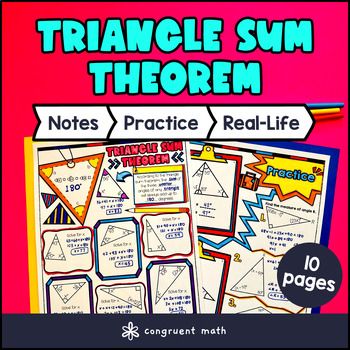Want more ideas and freebies?
Get my free resource library with digital & print activities—plus tips over email.
Join for free resources →
$4.25
Ever wondered how to teach the Triangle Sum Theorem in an engaging way to your 8th-grade students?
In this lesson plan, students will learn about the Triangle Sum Theorem and its real-life applications. Through artistic, interactive guided notes, check for understanding, practice coloring by code, and a maze worksheet, students will gain a comprehensive understanding of the theorem.
The lesson ends with a real-life example that explores how the Triangle Sum Theorem can be applied to solve real-world geometric problems.

$4.25
After this lesson, students will be able to:
Before this lesson, students should be familiar with:
As a hook, ask students why understanding the Triangle Sum Theorem is important in real-life situations involving shapes and angles. Refer to the last page of the guided notes as well as the FAQs below for ideas.
Use the first page of the guided notes to introduce the Triangle Sum Theorem, explaining how the sum of the three interior angles of a triangle is always 180 degrees. Walk through the key points of the theorem to teach, emphasizing the relationship between the angles in a triangle. Refer to the FAQ below for a walk through on this, as well as ideas on how to respond to common student questions.
For the second page of the guided notes, continue by demonstrating how to apply the Triangle Sum Theorem to solve for missing angles in triangles. Highlight different types of triangle problems where students need to calculate the missing angles or set up equations to solve for the missing variables using the theorem. Verify student understanding by having them practice solving example problems. Refer to the FAQ below for additional support on teaching this concept effectively.
Based on student responses during the introduction, reteach concepts that students need extra help with, especially focusing on clarifying any misconceptions about the Triangle Sum Theorem. If your class has a wide range of proficiency levels, consider pulling out students for reteaching as needed while more advanced students start working on the practice exercises.
Have students practice solving problems involving the Triangle Sum Theorem using the practice worksheet provided in the resource. Students can practice using the maze activity (pg. 3) and the color by number activity (pg. 4). Walk around to answer student questions.
Fast finishers can dive into the real-life application activity for extra enrichment. You can assign it as homework for the remainder of the class.
Using the last page of the guided notes, bring the class back together, and introduce the concept of using the Triangle Sum Theorem in real life. Explain how the Triangle Sum Theorem is used to determine angles in structures like bridges, roofs, or even sports fields. Discuss how engineers and architects use this theorem to ensure the stability and integrity of their designs. Refer to the FAQ for more ideas on how to teach it!
If you’re looking for digital practice for Triangle Sum Theorem, try my Pixel Art activities in Google Sheets. Every answer is automatically checked, and correct answers unlock parts of a mystery picture. It’s incredibly fun, and a powerful tool for differentiation.
Here’s 1 activity to explore:
The Triangle Sum Theorem states that the sum of the interior angles of a triangle is always equal to 180 degrees.
To find a missing angle in a triangle using the Triangle Sum Theorem:
The Triangle Sum Theorem has various real-life applications, such as in:
Yes, the Triangle Sum Theorem can be applied to any type of triangle, whether it's equilateral, isosceles, scalene, or right-angled.
Guided Notes and Doodles aid in understanding the Triangle Sum Theorem by:
The Common Core Standard related to the Triangle Sum Theorem is:
Get my free resource library with digital & print activities—plus tips over email.
Join for free resources →